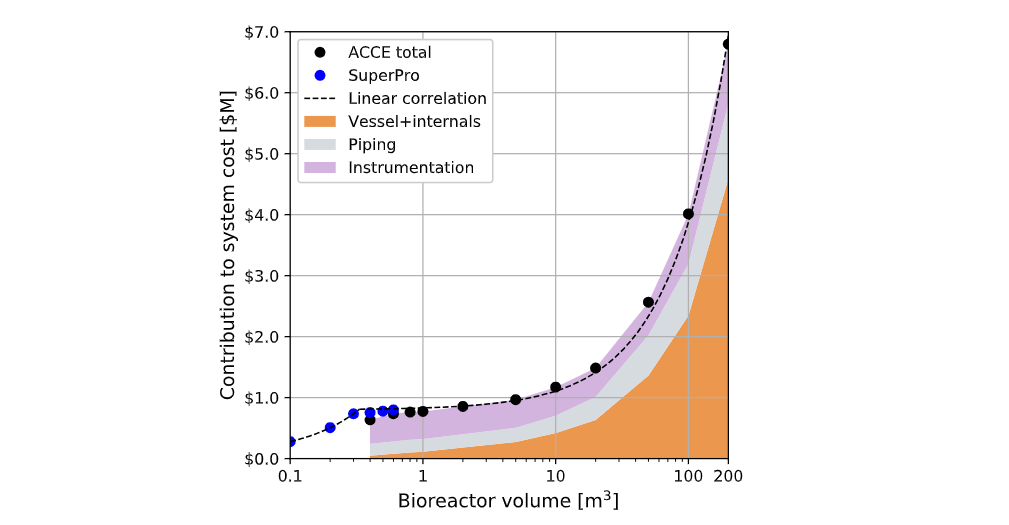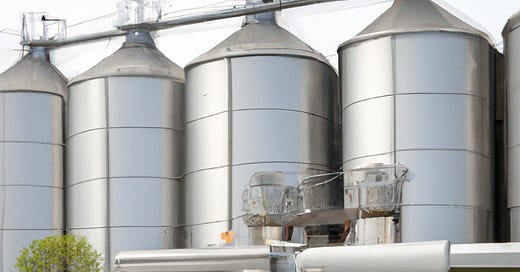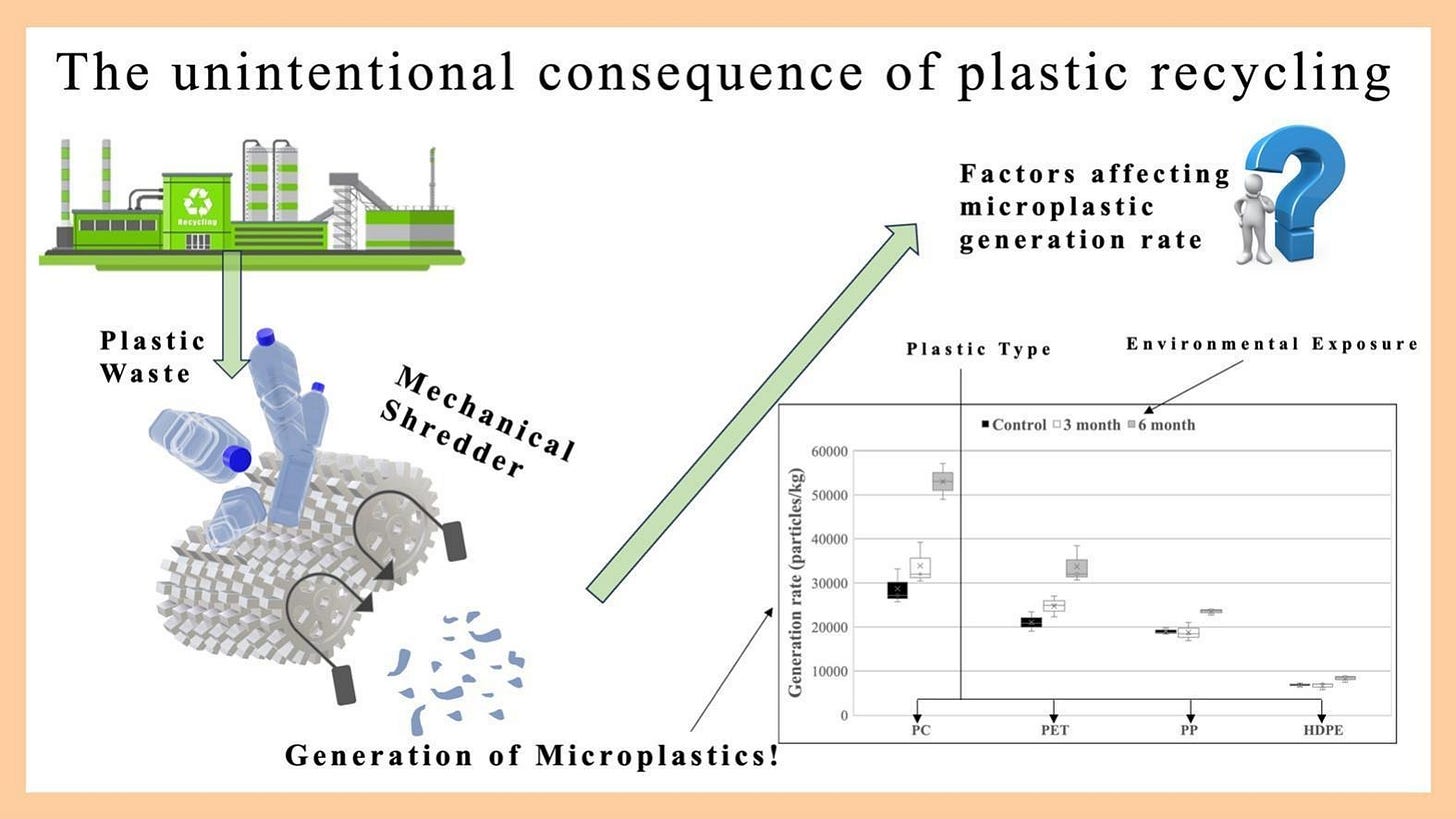105 | (Wow) Has Cultivated Meat's Big Problem Just Been Solved?
Plus plastic recycling's nasty little secret
This is The Rotten Apple, an inside view of food integrity for professionals, policy-makers and purveyors. Subscribe for weekly insights, latest news and emerging trends in food safety, food authenticity and sustainable supply chains.
Live discussion this Thursday: Ultra-processed foods, evil or genius?
(Wow) Did cultivated meat’s big problem just get solved?
Is it safe to eat banana peels (the science of edible)
Food safety news - infant formula factories without food safety controls
Uh oh, plastic recycling and microplastics
Plant-based milks: good for the planet but bad for humans?
Food fraud: The financial impacts of the melamine milk scandal revealed
🎧 Listen Now (for paying subscribers) 🎧
Happy Monday!
Welcome to The Rotten Apple. If you are new here, thank you for joining us. My mission is to keep you up to date with the most important developments in food safety, food fraud and sustainable food from around the globe, without boring you.
Are you sick of hearing about how cultivated meat will soon be feeding the world and saving the planet? That’s baloney. Or at least a very VERY long way off. But there has been an exciting breakthrough, which I unpack this week.
Also this week: unfortunate side-effects from plastic recycling, plant-based milk woes, and why did German scientists study the edible-ness of banana peels?
As always, this issue ends with food fraud news and incidents from around the world for paying subscribers. You can peek below the paywall and check out all the other benefits of a paid subscription - with a free 7 day trial, just click the green button on the paywall.
Thank you for reading, and have a lovely week,
Karen
P.S. If you enjoy this newsletter, please consider upgrading to a paid subscription. Your contribution helps support high-quality, independent, ad-free food news for a safer more sustainable world.
Join Us: Ultra-processed foods, evil or genius?
Live discussion for readers of The Rotten Apple
Join me and other like-minded readers this Thursday for an online discussion about ultra-processed foods.
The topic was going to be food safety culture, but ultra-processed food is a way hotter topic this month.
Everyone is welcome, both free and paid subscribers.
🍏 Details here: Ultra-processed foods, evil or genius? Live Discussion🍏
Cultivated Meat: Solved?
The missing ‘ingredient’ in ethical, cost-effective cultivated meat production
Are you sick of hearing about how cultivated meat will soon be feeding the world while saving the planet? I am. Cultivated meat (also known as cell-cultured meat) is a phenomenal technology but right now it’s incredibly expensive to make, in terms of both money and energy.
What type of investor would choose to spend hundreds of millions of dollars to build and operate a high-tech facility in a developing country where food is typically sold for low prices?

That’s a capital investment - infrastructure - problem… one for another day. Today, I want to share exciting news about a solution to an input problem, which is a contributor to the cost of production for cultivated meat.
The problem
The problem is that many cultivated meat developers rely on fetal bovine serum (FBS). As the animal cells grow to form meat, they are suspended in FBS - a liquid - which supplies them with the nutrients and growth-promoting substances they need to thrive and replicate.
FBS alternatives are being trialled but have not replaced FBS at scale so far.
For example, Upside Foods, which gained US regulatory approval for cultivated chicken meat last year, said at the time it was “currently optimizing its process to phase out the use of whole animal serum, as well as animal serum constituents, during the meat production phase.”
FBS is collected from the foetuses of slaughtered pregnant cows, so it’s hardly an ‘ethically sourced’ material. Also, it’s very expensive, costing hundreds of dollars per litre. The cultivated meat industry’s reliance on FBS for efficient cell growth is one of the reasons that cultivated meat processors have been slow to scale up production and reduce prices for finished products.
One expert estimated (in 2018) that it takes 50 litres of FBS to make a single cultured beef burger, rendering the cost so prohibitive that the authors of this paper state that “a serum requirement for [the cultured meat manufacturing] process render[s] it completely infeasible at scale”.
The solution
The man behind a solution to the FBS problem, Dr Ali Khademhosseini, comes from a human medicine background, with professorships at Harvard Medical School and Harvard University. He brought a fresh perspective to the problem.
Instead of taking FBS from dead cow foetuses, he began taking serum from living cows, much as human volunteers donate blood for medical uses. The ‘donation’ process only involves the collection of blood plasma, not whole blood, in a process known as exchange transfusion.
This process, he told me, is “more benign” for the cows than whole blood collection, because plasma regeneration takes only 3 to 4 days, compared to 90 days for blood regeneration.
Dr Khademhosseini told Food Navigator that his company, Omeat, can collect 10 litres of plasma from a single cow per week, and said “these 10 litres of plasma are as potent as FBS. So instead of having to slaughter many foetuses and their mothers to be able to get the equivalent amount of FBS, we can get that much from a cow in a week without having to slaughter it.”

Omeat has begun steps to supply the plasma-derived growth medium, which they call Plenty, to other cultivated meat producers. If it proves to be a suitable alternative to FBS, this could be a major breakthrough in bringing down the cost of cultivated meat.
Questions (answered)
Foetuses and placentas? I asked Dr Khademhosseini whether the plasma used to make Plenty had to be collected from pregnant cows, or even their placentas, in order for it to contain sufficient growth promoters and nutrients. He said it did not.
Food safety issues? The food safety impact of switching from FBS to Plenty for culturing meat seems negligible because food safety hazards from live-cow plasma are likely to be similar to those in FBS.
In short: 🍏 Foetal bovine serum (FBS) is used to make some cultivated meat products 🍏 FBS is effective for growing meat cells but is expensive and must be collected from slaughtered cow foetuses 🍏 An alternative has been launched, which is collected from living cows 🍏 It is cheaper and more ethical than FBS 🍏 It is used by a cultivated meat company in its process, and they are planning to supply it to other cultivated meat producers 🍏
Learn more:
See the full interview with Dr Khademhosseini in this Food Navigator article
Read Omeat’s animal welfare statement here
Nerd out on a peer-reviewed paper about scale-up challenges and estimated production costs for cultivated meat
Cultivated or cultured meat? Read about a consensus agreement on naming in FoodIngredientsFirst.
Four surprising facts I uncovered in the FDA’s food safety analysis of Upside Foods, plus one burning question about prions (‘mad cow disease’)
The Good Food Institute explains meat cell culture media for cultivated meat production
Food Safety News and Resources
11 September | Food Safety News and Free Resources | Food safety failures at infant formula making facilities (USA) | Disposable gloves hygiene testing | Listeriosis deaths linked to cold smoked salmon (Sweden) | Updated allergen labelling guidance (United Kingdom) |
Is it safe to eat banana peels?
My grandmother ate mandarin peel (you might know mandarins as clementines or satsumas). 🍊 It grossed us out as kids. Was it a side-effect of having lived through the Great Depression or was she just showing off by picking the discarded skins off our plates and popping them in her mouth? I don’t know.
(Yes, we tried eating mandarin peel too. No, it isn’t particularly unpleasant to eat.)
I don’t habitually eat mandarin peel these days, but I do eat the skin of Kiwi fruit – too lazy to peel them. However, it’s never crossed my mind to munch on a banana peel.
Now, a new trend in Western cultures of using banana peel in recipes has inspired German researchers to tackle the food safety characteristics of banana peel. It is common to feed banana peels to animals, and they are used in certain recipes in Venezuela, India and Southeast Asia. But are they safe as an everyday human food source?

The researchers quantified nutrients and pesticide residues by testing both conventional and organic bananas from various countries. They found (unsurprisingly) that banana peel contains more fibre and less carbohydrate than banana flesh. It also has higher levels of calcium and magnesium but lower levels of potassium compared to the flesh.
With respect to pesticide residues, conventionally grown bananas had more pesticide residues in their skins compared to their flesh, as you would hope (!). Organically grown bananas had fewer pesticide residues in their skins than conventionally grown bananas. All the residues were low: for the samples tested, even the conventionally grown bananas had pesticide levels below EU safety limits.
The researchers concluded that banana peel is safe to eat and advised “…if you want to avoid pesticide residues as much as possible, you should only eat the peel of organic bananas.”
🍏 Banana peel pulled pork recipe on Instagram 🍏
🍏 Responses to Nigella Lawson’s curry with banana peel 🍏
Source:
www.ua-bw.de. (n.d.). CVUA Stuttgart | Ob mit oder ohne Schale –... [online] Available at: https://www.ua-bw.de/pub/beitrag.asp?subid=1&Thema_ID=5&ID=3808&lang=DE&Pdf=No [Accessed 11 Sep. 2023].
Plastic recycling factories generate plastic pollution (what now?!)
Plastic recycling processes generate “large amounts” of microplastics, which end up in wastewater and sludge produced by recycling facilities, according to new research published in Science of The Total Environment. The wastewater and sludges end up in waterways and landfill sites.
Recycling facilities generate microplastics during the mechanical shredding processes used in the early stages of plastic recycling. The quantity generated depends on the hardness of the plastic being shredded, with polycarbonate being much worse than high-density polyethylene.
If the plastic has been exposed to environmental weathering, such as being left out in the sun, before recycling, more microplastics are generated, compared to when ‘fresh’ plastic is shredded. Six months of environmental exposure doubles or even triples the rate of microplastic generation. Sigh.
Source: Stapleton, M.J., Ansari, A.J., Ahmed, A. and Hai, F.I. (2023). Evaluating the generation of microplastics from an unlikely source: The unintentional consequence of the current plastic recycling process. Science of The Total Environment, 902, pp.166090–166090. doi: https://doi.org/10.1016/j.scitotenv.2023.166090.
Plant-based milks: good for the planet, not so good for humans?
Replacing a glass of dairy milk with a glass of plant-based milk reduces greenhouse gas emissions by two-thirds and land use by a whopping 89% (source).
Weirdly, though, most consumers who choose plant-based milk over dairy milk don’t do it for environmental reasons. Health reasons are the number one driver for choosing plant-based milks with respondents in a global survey saying they choose plant-based milks to “feel healthier” and “because I digest them better”. Environmental reasons ranked significantly lower in the same global survey.

Given that consumers choose plant-based milks for their health, it’s unfortunate that research shared at a nutrition conference in the USA in July showed that few US-produced plant-based milks were nutritionally equivalent to cows’ milk for calcium, vitamin D and protein content. The results are based on testing of 223 commercially available plant-based milks made from almond, oats, soy, tree nuts, hemp, rice and coconut.
The lead researcher suggested that consumers should choose plant-based milks fortified with both calcium and vitamin D and also reminded conference attendees that plant-based milks can contain other micronutrients and nutrients, such as fibre, which are not in cows’ milk.
What you missed in last week’s email
• Massive blind spot leads to huge soy recall
• A new CCP decision tree from Codex
• How beautiful Japanese sweets are made (just for fun)
• Food fraud news and incidents
Below for paying subscribers: Food fraud news and incident reports, plus an 🎧 audio archive 🎧 for your listening pleasure
📌 Food Fraud News 📌
Milk exports plummetted after food fraud scandal
Entire sectors of the food industry can be damaged by food fraud events, as consumer confidence decreases and trading patterns are interrupted.
These interruptions can have economic consequences at national and international levels. A recent analysis of the impact of the melamine milk powder scandal in China (2008) evidences the “seismic effect” it had on domestic dairy production and exports of other Chinese food products. The analysis





